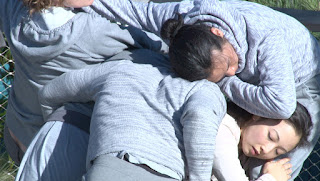Week 4 MedTech + Art
Being a mechanical engineering student, it was difficult for me to imagine how medical technologies can be linked to art. However, after viewing this week's course materials, I found that art is embedded in medicine, and vice versal.
In Lecture Part 1, Professor Vesna mentioned that artists have been interested in human dissection since ancient period. They were trying to look into the body, understand how the human body works, and represent it as art forms. The art products, for example, an anatomical diagram, a small-scale artificial human skeleton, are generally used by doctors to help understand or analyze human diseases. This reminds me of Chinese medicine. The science of acupuncture and moxibustion is an important division of traditional Chinese medicine. For thousand of years, the Chinese people have taken advantages of it due to its nonpharmaceutical treatment, simple application, wide range of use, good curative effect, and low cost. Acupuncturists were usually trained by memorizing acupoints and practicing on a small scale artificial human model. These art products were considered as their learning tools.
In Lecture Part 1, Professor Vesna mentioned that artists have been interested in human dissection since ancient period. They were trying to look into the body, understand how the human body works, and represent it as art forms. The art products, for example, an anatomical diagram, a small-scale artificial human skeleton, are generally used by doctors to help understand or analyze human diseases. This reminds me of Chinese medicine. The science of acupuncture and moxibustion is an important division of traditional Chinese medicine. For thousand of years, the Chinese people have taken advantages of it due to its nonpharmaceutical treatment, simple application, wide range of use, good curative effect, and low cost. Acupuncturists were usually trained by memorizing acupoints and practicing on a small scale artificial human model. These art products were considered as their learning tools.
An ancient Chinese text on acupuncture and moxibustion
Art is usually presented when developing new technologies. From the late 1980s to middle 1990s, the visible human project created detailed data sets of cross-sectional photographs of the human body in order to facilitate anatomy visualization applications. In Lecture Part 2, Professor Vesna introduced medical technologies at the most cutting edge such as X-ray, CAT, and MRI scan which enable doctors to diagnose diseases without cutting human body open. This actually drags me to my major field. My current research project is related to lens- free on-chip microscopy, which takes an alternative approach and uses an optoelectronic sensor array to sample an object's diffraction pattern to reconstruct its image. The last part of our project is actually a coloring process. We apply digital colorization algorithms to provide color representation of the reconstructed image.
Lens-free image reconstruction for a pathology slide
It might be difficult to think about the connection between most medical technologies and art. However, I would definitely say plastic surgery, the incredible medical technology, is an artwork even though I have not taken this class. At war time, this technology enables soldiers to restore their missing limbs. However, nowadays, this medical technology is widely used in beauty industry to help people gain confidences instead of healing diseases. For example, it is considered as a part of the culture of South Korea. I would call people who operate plastic surgery "artists" rather than "plastic surgeon".
A plastic surgery advertisement
References
"Brief History of Acupuncture and Moxibustion." The Philippine Institute of Traditional and Alternative Health Care (PITAHC), 16 Mar. 2016, pitahc.wordpress.com/2016/03/16/brief-history-of-acupuncture-and-moxibustion-2/. Accessed 30 April 2017.
Greenbaum, Alon, Yibo Zhang, Alborz Feizi, Ping-Luen Chung, Wei Luo, Shivani R. Kandukuri, and Aydogan Ozcan. "Wide-field computational imaging of pathology slides using lens-free on-chip microscopy." Science Translational Medicine, 17 Dec. 2014, stm.sciencemag.org/content/6/267/267ra175/tab-pdf. Accessed 30 April 2017.
"Plastic Surgery in South Korea." Seoul TouchUp, www.seoultouchup.com/plastic-surgery-in-korea/. Accessed 30 April 2017
Vesna, Victoria. "Medicine pt1." YouTube, uploaded by Uconlineprogram, 21 April 2012, www.youtube.com/watch?v=Ep0M2bOM9Tk.
Vesna, Victoria. "Medicine pt2." YouTube, uploaded by Uconlineprogram, 21 April 2012, www.youtube.com/watch?v=psjnQarHOqQ.
Vesna, Victoria. "Medicine pt3." YouTube, uploaded by Uconlineprogram, 22 April 2012, www.youtube.com/watch?v=FIX-9mXd3Y4.





Comments
Post a Comment